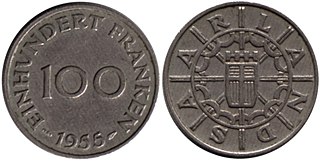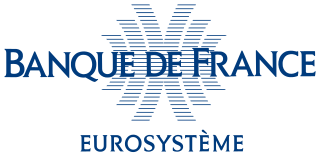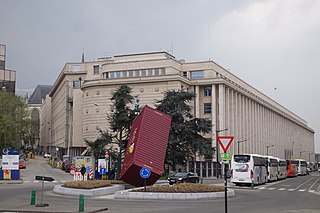
The CFA franc, or Franc of the Financial Community of Africa, is the name of two currencies, the West African CFA franc, used in eight West African countries, and the Central African CFA franc, used in six Central African countries. Although separate, the two CFA franc currencies have always been at parity and are effectively interchangeable. The ISO currency codes are XAF for the Central African CFA franc and XOF for the West African CFA franc.

The franc is any of various units of currency. One franc is typically divided into 100 centimes. The name is said to derive from the Latin inscription francorum rex used on early French coins and until the 18th century, or from the French franc, meaning "frank".
Seigniorage, also spelled seignorage or seigneurage, is the difference between the value of money and the cost to produce and distribute it. The term can be applied in two ways:

Robert Alexander Mundell was a Canadian economist. He was a professor of economics at Columbia University and the Chinese University of Hong Kong.

The Swiss franc, or simply the franc, is the currency and legal tender of Switzerland and Liechtenstein. It is also legal tender in the Italian exclave of Campione d'Italia which is surrounded by Swiss territory. The Swiss National Bank (SNB) issues banknotes and the federal mint Swissmint issues coins.

The Bank of France is the French member of the Eurosystem. It was established by Napoleon Bonaparte in 1800 as a private-sector corporation with unique public status. It was granted note-issuance monopoly in Paris in 1803 and in the entire country in 1848, issuing the French franc. Charles de Gaulle's government nationalized the bank in 1945 after several governance changes in the meantime. It remained France's sole monetary authority until end-1998, when France adopted the euro as its currency.
Foreign exchange reserves are cash and other reserve assets such as gold and silver held by a central bank or other monetary authority that are primarily available to balance payments of the country, influence the foreign exchange rate of its currency, and to maintain confidence in financial markets. Reserves are held in one or more reserve currencies, nowadays mostly the United States dollar and to a lesser extent the euro.

The National Bank of Belgium is the Belgian member of the Eurosystem. It was established by a law of 5 May 1850 and has been the monetary authority for Belgium from then until 1998, issuing the Belgian franc.
This history of central banking in the United States encompasses various bank regulations, from early wildcat banking practices through the present Federal Reserve System.

The Belgian franc was the currency of the Kingdom of Belgium from 1832 until 2002 when the Euro was introduced. It was subdivided into 100 subunits, each known as a centiem in Dutch, centime in French or a Centime in German.
The franc is the official currency of Comoros. It is nominally subdivided into 100 centimes, although no centime denominations have ever been issued.

The Swiss National Bank is the central bank of Switzerland, responsible for the nation's monetary policy and the sole issuer of Swiss franc banknotes. The primary goal of its mandate is to ensure price stability, while taking economic developments into consideration.

The Bank of Central African States is a central bank that serves six central African countries which form the Economic and Monetary Community of Central Africa: Cameroon, Central African Republic, Chad, Equatorial Guinea, Gabon, and the Republic of the Congo.

The Bank of the Republic of Burundi is the central bank of Burundi. The bank was established in 1966 and its offices are in Bujumbura.

The Central Bank of the Comros is the central bank of the Comoros, a group of islands in the Indian Ocean.
The Washington Agreement on Gold was signed on 26 September 1999 in Washington, D.C. during the International Monetary Fund (IMF) annual meeting, and the US Secretary of the Treasury, Lawrence Summers, and the Chairman of the Federal Reserve, Alan Greenspan, were present. The second version of the agreement was signed in 2004, the agreement was extended in 2009.

Currency intervention, also known as foreign exchange market intervention or currency manipulation, is a monetary policy operation. It occurs when a government or central bank buys or sells foreign currency in exchange for its own domestic currency, generally with the intention of influencing the exchange rate and trade policy.

Liechtensteinische Landesbank AG, trading as LLB, is a financial institution located in Liechtenstein, based in the capital city Vaduz. Since 1993 it has been listed as a company at the SIX Swiss Exchange, with the majority of shares (57.5%) owned by the Liechtenstein state. As the state is in a customs and monetary union with Switzerland and has adopted the Swiss franc as official currency, the monetary policy and money supply is the sole responsibility of the Swiss National Bank (SNB).
Twelve national referendums were held in Switzerland during 2014.
Ten national referendums were held in Switzerland in 2018. Voting took place on 4 March, 10 June, 23 September and 25 November.













